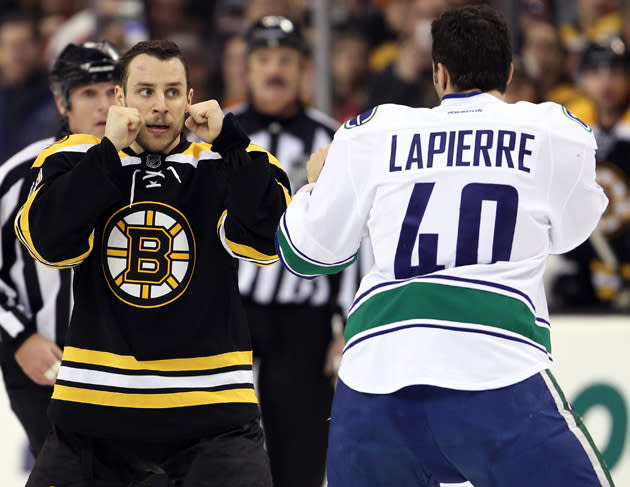The fighter-scorer is as rare as the 40-goal scorer, and almost as valuable

While the waiving of Colton Orr may not have signified the end of the pure fighter, it certainly signified the beginning of the end.
If Orr can't stick in Toronto, where I wouldn't be shocked to learn that GM Brian Burke has a "truculence" stencil on the wall behind his desk, there aren't many places left for guys like him. But don't think Orr's dismissal marks the end of fighting or the end of toughness. Far from it -- it merely marks the shift. The pure fighter is the past.
The fighter-scorer, however, is the future. He's also among the most coveted player types in hockey right now.
Last year's Boston Bruins were the quintessential example of what can happen if the players providing your toughness are versatile. It wasn't just that Boston had guys that could drop the gloves -- it's that those guys were still plenty effective when they held onto their equipment.
The Bruins had two players finish in double digits in fighting majors in 2010-11 -- Shawn Thornton and Gregory Campbell -- and both those players finished in double digits in goals as well. Thornton had 10 goals and 14 majors; Campbell had 13 and 11.
Let me put into perspective how impressive this is: there were only seven players in the entire NHL that reached 10 goals and 10 majors in 2010-11, and Boston had two of them.
The other five, if you're wondering, were Ryane Clowe (24 G, 12 MAJ), Brandon Prust (13 G, 18 MAJ), David Clarkson (12 G, 14 MAJ), Tim Jackman (10 G, 12 MAJ), and Steve Ott (12 G, 11 MAJ).

As we near the halfway point in the 2011-12 schedule, with most teams having played 41 games now, the numbers of players projected to reach the milestone is even lower.
As of this writing, only four players have 5 goals and 5 fights: David Clarkson, with 15 goals and 6 majors, Wayne Simmonds, with 10 goals and 5 majors, 22-year-old Matt Martin, who has matched the 5 goals from his rookie season in 30 fewer games and has 6 majors to go along with that, and Derek Dorsett of the Columbus Blue Jackets. Dorsett has 7 goals and 10 fights already this season.
There are a few other players that could reach 10/10 with strong second halves, as Gregory Campbell, Steve Downie, Steve Ott, Jordin Tootoo, Chris Neil, Maxim Lapierre and Ryane Clowe are all within striking distance. I doubt all of them will get there, but I wouldn't be surprised to see last year's total of seven repeated.
Seven. Would you believe that it's rarer to post 10 goals and 10 fights than to score 30 goals? There were twenty-nine 30-goal-scorers last season. Heck, fighter-scorers are almost as rare as 40-goal scorers, of which there were five.
And they're almost as vital to deep, successful teams.
What the 2009-10 Chicago Blackhawks and the 2010-11 Boston Bruins have shown us is that there isn't room in a Stanley Cup-winning lineup for a player that can't take regular shifts. You need four complete lines that can score, as those teams boasted, and you simply can't waste spots on one-dimensional pugilists.
Nowadays, if you want toughness (and you need toughness), you either get a guy who can fight and play, or you willfully dress a flaw. Last I checked, the team that wins is the team with the fewest flaws, so starting with a one-flaw handicap is hardly efficient.
The fighter-scorer, however, very much is.

 Yahoo Sports
Yahoo Sports 

